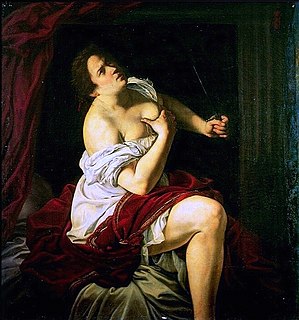Cleopatra was the last active Ptolemaic ruler of Egypt before it became a Roman province.

Artemisia Lomi or Artemisia Gentileschi was an Italian Baroque painter. Gentileschi is considered among the most accomplished seventeenth-century artists, initially working in the style of Caravaggio. She was producing professional work by the age of fifteen. In an era when women had few opportunities to pursue artistic training or work as professional artists, Gentileschi was the first woman to become a member of the Accademia di Arte del Disegno in Florence and she had an international clientele.

Orazio Lomi Gentileschi (1563–1639) was an Italian painter. Born in Tuscany, he began his career in Rome, painting in a Mannerist style, much of his work consisting of painting the figures within the decorative schemes of other artists. After 1600, he came under the influence of the more naturalistic style of Caravaggio. He received important commissions in Fabriano and Genoa before moving to Paris to the court of Marie de Medici. He spent the last part of his life at the court of Charles I of England. He was the father of the painter Artemisia Gentileschi.
Painted Lady was a 1997 murder mystery drama starring Helen Mirren, involving art theft. It co-starred Franco Nero, Karl Geary and Iain Glen, and was directed by Julian Jarrold.
Events from the year 1610 in art.

Massimo Stanzione was an Italian Baroque painter, mainly active in Naples, where he and his rival Jusepe de Ribera dominated the painting scene for several decades. Most of his work, in both oils and fresco, depicted religious subjects. A papal knight, he is often referred to as Cavalliere Massimo Stanzione, especially in older sources.

The account of the beheading of Holofernes by Judith is given in the deuterocanonical Book of Judith, and is the subject of many paintings and sculptures from the Renaissance and Baroque periods. In the story, Judith, a beautiful widow, is able to enter the tent of Holofernes because of his desire for her. Holofernes was an Assyrian general who was about to destroy Judith's home, the city of Bethulia. Overcome with drink, he passes out and is decapitated by Judith; his head is taken away in a basket.

Artemisia is a 1997 French-German-Italian biographical film about Artemisia Gentileschi, the female Italian Baroque painter. The film was directed by Agnès Merlet, and stars Valentina Cervi and Michel Serrault.

Judith Slaying Holofernes is a painting by the Italian early Baroque artist Artemisia Gentileschi, completed in 1612-13 and now at the Museo Capodimonte, Naples, Italy. It is considered one of her iconic works. The canvas shows Judith beheading Holofernes. The subject takes an episode from the apocryphal Book of Judith in the Old Testament, which recounts the assassination of the Assyrian general Holofernes by the Israelite heroine Judith. The painting shows the moment when Judith, helped by her maidservant Abra, beheads the general after he has fallen asleep in a drunken stupor. She painted a second version now in the Uffizi, Florence, somewhere between 1613 and 1621.
Penitent Magdalene or Penitent Magdalen refers to a post-biblical period in the life of Mary Magdalene, according to medieval legend, and a large number of artworks showing this subject, including:

Massimo Stanzione's David with the Head of Goliath is exhibited at the San Diego Museum of Art.

The Galleria Spada is a museum in Rome (Italy), which is housed in the Palazzo Spada of the same name, located in the Piazza Capo di Ferro. The palazzo is also famous for its façade and for the forced perspective gallery by Francesco Borromini.
Judith and Holofernes may refer to:
The Lute Player is a Russian fairy tale

Esther before Ahasuerus is a painting by the 17th century Italian artist Artemisia Gentileschi. It shows the biblical heroine Esther going before Ahasuerus to beg him to spare her people. The painting is now in the Metropolitan Museum of Art in New York, having been donated to the museum by Elinor Dorrance Ingersoll in 1969. It is one of Gentileschi's lesser known works, but her use of lighting, characterization, and style help in successfully portraying Esther as a biblical heroine as well as the main protagonist of the work.

Judith and Her Maidservant is one of four paintings by the Italian baroque artist Artemisia Gentileschi that depicts the biblical story of Judith and Holofernes. This particular work, executed in about 1623 to 1625, now hangs in the Detroit Institute of Arts. The narrative is taken from the deuterocanonical Book of Judith, in which Judith seduces and then murders the general Holofernes. This precise moment illustrates the maidservant Abra wrapping the severed head in a bag, moments after the murder, while Judith keeps watch. The other three paintings are now shown in the Museo di Capodimonte in Naples, the Palazzo Pitti in Florence, and the Musée de la Castre in Cannes.

Susanna and the Elders is a painting by the Italian artist Artemisia Gentileschi. It is signed with Gentileschi's name and the date of 1622. The painting is in the collection at Burghley House near Stamford, Lincolnshire, England.

Lucretia is a painting by the Italian baroque artist Artemisia Gentileschi. It depicts Lucretia, the wife of Roman consul and general Tarquinus, at the moment of her suicide. The decision to take her own life was made after she was blackmailed and raped by a fellow soldier of Tarquinus. It is one of a number of paintings of Gentileschi that focus on virtuous women ill-treated by men.

Annunciation is a 1600-1605 oil on alabaster painting by Orazio Gentileschi, later mounted on slate. Produced in Rome for an unknown private commissioner, it is now in Álvaro Saieh and Ana Guzmán's residence as part of the Alana collection in Newark, Delaware, USA.

David and Goliath is a painting of David and Goliath by the seventeenth-century artist Artemisia Gentileschi.













